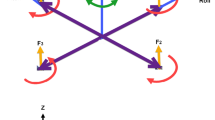Abstract
In this paper, a new robust controller is developed and analyzed for an autonomous vehicle (AV) with nonholonomic dynamics driving in a 2D plane that can avoid colliding with a set of obstacles despite the presence of uncertainties in the mathematical model of the AV. The state variables and their velocities are considered to be measurable (two simple coordinates and three angles). The controller is based on the integral sliding mode (ISM) concept, which aims to minimize the current state’s convex (but not necessarily strongly convex) function. A cost function’s subgradient is likewise designed to be measured online. The averaged subgradient (ASG) technique is used to build and analyze an optimization algorithm. The major findings show that the intended regime (non-stationary analogue of sliding surface) can be reached from the start of the process and deriving an explicit upper bound for the cost function decrement, i.e., proving functional convergence and estimating the rate of convergence, thereby allowing for multiple obstacle avoidance. The proposed strategy is shown to perform effectively with a numerical example.






Similar content being viewed by others
Data availability
Not applicable for this section.
References
Shi-gung, Q.Z., Quan-jun, Y., YinYa-bnig, Z.: Dynamic obstacle-avoiding path planning for robots based on modified potential field method. Springer (2013). https://doi.org/10.1007/978-3-642-39482-9_39
Khatib, O.: Real time, osbtacle avoidance for manipulators and mobile robots. In: The International of Robotics Research, pp. 90, 98, (1986). https://doi.org/10.1007/s10514-012-9287-y
Mansur Fantazzini, T., Arns Steiner, M.T.: Vehicle routing problem solved through heuristics procedures: A case study. IEEE Latin Am. Trans. 17(5), 858–864 (2019). https://doi.org/10.1109/TLA.2017.7910210
Huaman Loayza, A.S., Perez Zuñiga, C.G.: Design of a fuzzy sliding mode controller for the autonomous path-following of a quadrotor. IEEE Latin Am. Trans. 17(6), 962–971 (2019). https://doi.org/10.1109/TLA.2019.8896819
Ferrara, A., Utkin, V.I.: Sliding mode optimization in dynamic lti systems. J. Optim. Theory 115(3), 727–740 (2002). https://doi.org/10.1023/A:1021267517097
Poznyak, A., Nazin, A., Alazki, H.: Integral sliding mode convex optimization in uncertain lagrangian systems driven by p.m.d.c motors: Averaged subgradient approach. IEEE Trans. Auto. Control 66(9), 4267–4273 (2021). https://doi.org/10.1109/TAC.2020
Liu, Y., Geng, Z.: Finite-time optimal formation tracking control of vehicles in horizontal plane. Nonlinear Dyn. 11(76), 481–495 (2013). https://doi.org/10.1007/s11071-013-1141-z
Yuan, J., Chen, H., Sun, F., Huang, Y.: Trajectory planning and tracking control for autonomous bicycle robot. Nonlinear Dyn. 5(78), 421–431 (2014). https://doi.org/10.1007/s11071-014-1449-3
Guo, J., Luo, Y., Li, K.: Dynamic coordinated control for over-actuated autonomous electric vehicles with nonholonomic constraints via nonsingular terminal sliding mode technique. Nonlinear Dyn. 4(85), 583–597 (2016). https://doi.org/10.1007/s11071-016-2708-2
Ao, H., Gao, F., Huang, J.: Barrier lyapunov functions-based fixed-time stabilization of nonholonomic systems with unmatched uncertainties and time-varying output constraints. Nonlinear Dyn. 99(1), 2835–2849 (2020). https://doi.org/10.1007/s11071-019-05450-3
Li, X., Song, S., Guo, Y.: Robust finite-time tracking control for euler lagrange systems with obstacle avoidance. Nonlinear Dyn. (2018). https://doi.org/10.1007/s11071-018-4202-5
Ferrara, A., Vecchio, C.: Collision avoidance strategies and coordinated control of passenger vehicles. Nonlinear Dyn. 49, 475–492 (2006). https://doi.org/10.1007/s11071-006-9110-4
Urakubo, T.: Feedback stabilization of a nonholonomic system with potential fields: Application to a two-wheeled mobile robot among obstacles. Nonlinear Dyn. 85, 1475-1487 (2015). https://doi.org/10.1007/s11071-015-2082-5
Dhaouadi, R., Abu Hatab, A.: Dynamic modelling of differential-drive mobile robots using lagrange and newton-euler methodologies: A uni- fied framework. Adv. Robot. Auto. (2013). https://doi.org/10.4172/2168-9695.1000107
Baruh, H.: Analytical dynamics. McGraw-Hills, (1999), ISBN: 0073659770
Bloch, A.M., Baillieul, J., Crouch, P.E., Marsden, J.E.: Nonholonomic mechanics and control. Springer-Verlag, New York (2002). https://doi.org/10.1007/b97376
Utkin, V., Poznyak, A., Orlov, A., Polyakov, Y.: Road map for sliding mode control design, 1st edn. Springer International Publishing, New York (2020). https://doi.org/10.1007/978-3-030-41709-3
Poznyak, A.: Advanced mathematical tools for automatic control engineers: deterministic techniques, vol. 1. Elsevier, Amsterdam, The Netherlands (2008). https://doi.org/10.1134/S0005117909110174
Funding
This research work has been financed by the authors without any external support.
Author information
Authors and Affiliations
Contributions
H. Vargas, equal idea conceptualization part. Equal formal analysis part. Equal investigation part. Equal methodology plan developer. Lead software user. Lead writing -original draft. Lead writing -edit and review. J. Meda, equal investigation part. Equal methodology plan developer. Supporting help in software use. Equal supervisor. Equal validation opinion. Supporting writing -edit and review. A. Poznyak, equal idea conceptualization part. Equal formal analysis part. Supporting investigation part. Supporting methodology plan developer. Supporting help in software use. Equal supervisor. Equal validation opinion. Supporting writing -edit and review.
Corresponding author
Ethics declarations
Code availability
Not applicable for this section.
Conflict of interest
Not applicable for this section.
Ethical approval
Not applicable for this section.
Consent to participate
Not applicable for this section.
Consent for publication
The authors authorized the publication of this work.
Additional information
Publisher's Note
Springer Nature remains neutral with regard to jurisdictional claims in published maps and institutional affiliations.
Rights and permissions
About this article
Cite this article
Vargas, H., Meda, J.A. & Poznyak, A. ASG version of integral sliding mode robust controller for AV nonholonomic 2D models avoiding obstacles. Nonlinear Dyn 108, 2875–2887 (2022). https://doi.org/10.1007/s11071-022-07408-4
Received:
Accepted:
Published:
Issue Date:
DOI: https://doi.org/10.1007/s11071-022-07408-4




